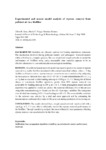Mostrar o rexistro simple do ítem
Experimental and neural model analysis of styrene removal from polluted air in a biofilter
| dc.contributor.author | Rene, Eldon R. | |
| dc.contributor.author | Veiga, María Carmen | |
| dc.contributor.author | Kennes, Christian | |
| dc.date.accessioned | 2014-10-28T12:29:39Z | |
| dc.date.available | 2014-10-28T12:29:39Z | |
| dc.date.issued | 2009-07 | |
| dc.identifier.citation | Rene ER, Veiga MC, Kennes C. Experimental and neural model analysis of styrene removal from polluted air in a biofilter. Journal of Chemical Technology and Biotechnology. 2009;84(7):941-8 | es_ES |
| dc.identifier.other | DOI: 10.1002/jctb.2130 | |
| dc.identifier.uri | http://hdl.handle.net/2183/13735 | |
| dc.description.abstract | BACKGROUND: Biofilters are efficient systems for treating malodorous emissions. The mechanism involved during pollutant transfer and subsequent biotransformation within a biofilm is a complex process. The use of artificial neural networks to model the performance of biofilters using easily measurable state variables appears to be an effective alternative to conventional phenomenological modelling. RESULTS: An artificial neural network model was used to predict the extent of styrene removal in a perlite-biofilter inoculated with a mixed microbial culture. After a 43 day biofilter acclimation period, styrene removal experiments were carried out by subjecting the bioreactor to different flow rates (0.15–0.9 m3 h−1) and concentrations (0.5–17.2 g m−3), that correspond to inlet loading rates up to 1390 g m−3 h−1. During the different phases of continuous biofilter operation, greater than 92% styrene removal was achievable for loading rates up to 250 g m−3 h−1. A back propagation neural network algorithm was applied to model and predict the removal efficiency (%) of this process using inlet concentration (g m−3) and unit flow (h−1) as input variables. The data points were divided into training (115 × 3) and testing set (42 × 3). The most reliable condition for the network was selected by a trial and error approach and by estimating the determination coefficient (R2) value (0.98) achieved during prediction of the testing set. CONCLUSION: The results showed that a simple neural network based model with a topology of 2–4–1 was able to efficiently predict the styrene removal performance in the biofilter. Through sensitivity analysis, the most influential input parameter affecting styrene removal was ascertained to be the flow rate. | es_ES |
| dc.language.iso | eng | es_ES |
| dc.publisher | Wiley-Blackwell | es_ES |
| dc.relation.uri | http://dx.doi.org/10.1002/jctb.2130 | es_ES |
| dc.rights | The definitive version is available at http://onlinelibrary.wiley.com/ | es_ES |
| dc.subject | Biofiltration | es_ES |
| dc.subject | Back propagation algorithm | es_ES |
| dc.subject | Modelling | es_ES |
| dc.subject | Neural networks | es_ES |
| dc.subject | Reactor performance | es_ES |
| dc.subject | Waste gas | es_ES |
| dc.title | Experimental and neural model analysis of styrene removal from polluted air in a biofilter | es_ES |
| dc.type | info:eu-repo/semantics/article | es_ES |
| dc.rights.access | info:eu-repo/semantics/openAccess | es_ES |
Ficheiros no ítem
Este ítem aparece na(s) seguinte(s) colección(s)
-
GI-BIOENGIN- Artigos [91]






